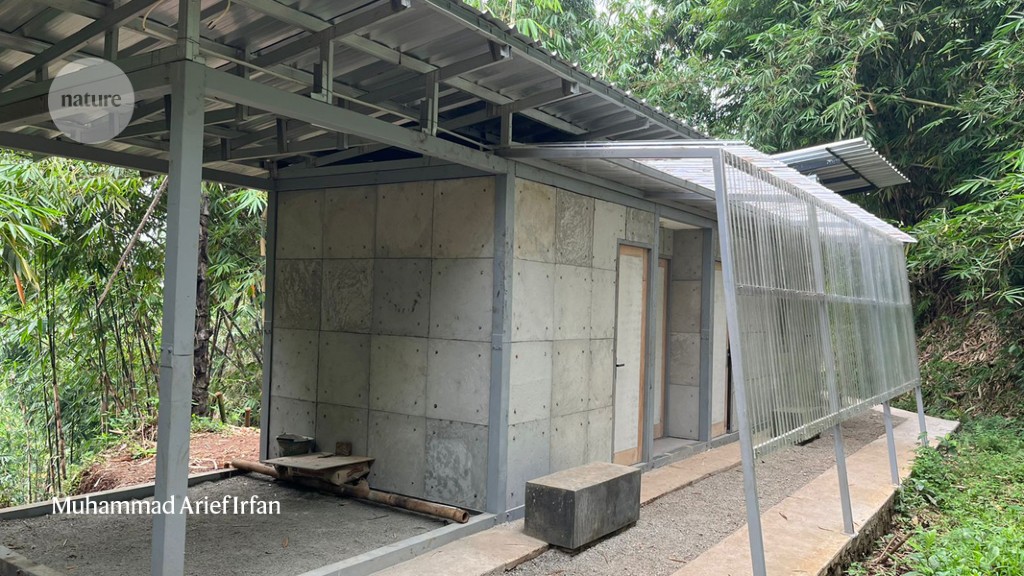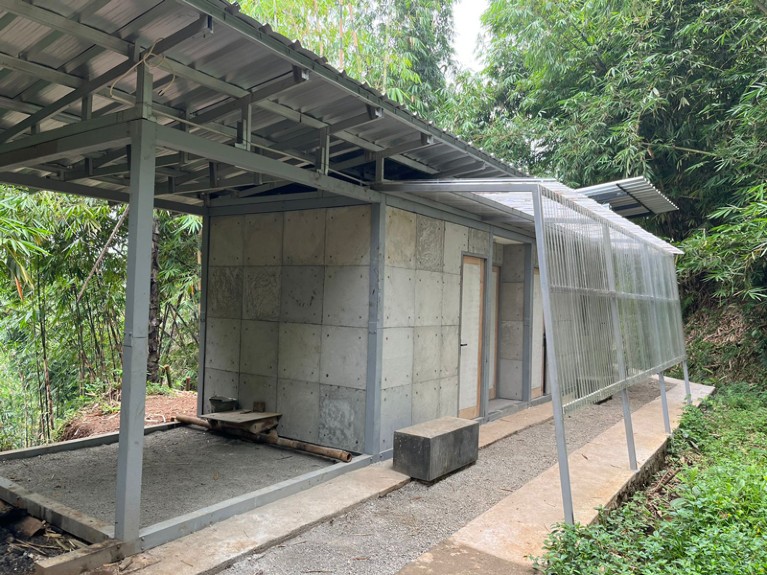The prototype nappy house in Indonesia, built with concrete made by mixing cement, sand, gravel and shredded waste from nappies.Credit: Muhammad Arief Irfan
In an attempt to solve two environmental problems at once, researchers at the University of Kitakyushu in Japan have found that shredded nappies can be used to replace between 9 and 40% of the sand used in making concrete without reducing its strength1. Disposable nappies are a growing source of non-recyclable waste, and cement production is responsible for almost 7% of global greenhouse-gas emissions and consumes around 50 billion tonnes of sand each year.
The nappy-infused concrete was used to build a small house in Indonesia, to demonstrate how this type of waste could be diverted from landfills to build more affordable housing in low- and middle-income communities.
Siswanti Zuraida, a civil engineer at the University of Kitakyushu, began the project while studying at the Bandung Science Technology Institute near Jakarta. Although population numbers in wealthy countries often plateau and decline, those in Indonesia and other low- and middle-income countries will continue growing — leading to more babies, more nappies and more demand for low-cost housing.
“It’s all about the resource availability,” says Zuraida. “With the growth of the population, the diaper waste will also grow. It’s challenging, so we thought that this would be a part of our contribution to recycling this waste.”
Single-use nappies are typically made from wood pulp, cotton and super-absorbent polymers, small amounts of which have been shown to improve the mechanical properties of concrete. With funding from a Jakarta-based waste-management company called Awina, Zuraida set out to determine how much sand could be swapped for shredded nappies to create useful concrete and mortar.
Close to home
Initially, the researchers sourced the nappies locally — Zuraida has a toddler of her own. After the nappies were washed, dried and shredded, the resulting material was combined with cement, sand, gravel and water. The team tested different mixes, replacing up to 40% of the sand in the concrete.
After a month of curing, the samples were pressure-tested to determine the breaking point of the composite material. From these measurements, Zuraida and her colleagues calculated the maximum proportion of nappy waste that could match the needs of building components.
The more nappy waste in the concrete, the lower the compressive strength. Structural components such as columns and beams therefore needed a smaller proportion of shredded nappies than did architectural elements, such as walls and concrete blocks. For their prototype single-storey house, the researchers calculated that 27% of the sand could be replaced by nappy waste. But if the house was three storeys tall, the proportion would need to drop to 10%.
In architectural components, up to 40% of the sand could be replaced by nappy waste, with the highest proportion in concrete wall panels. In flooring and garden paving, which need to be stronger than walls to meet building standards, just 9% of the sand could be replaced by nappies.
The house that nappies built
The researchers then used their nappy-infused concrete to construct their experimental house to Indonesian building standards. The house was small; the floor plan totalled just 36 square metres, the size of about 2.5 car-parking spaces. To speed up the building process, the researchers used the nappy concrete for the architectural components and metal beams for the structural components.
In total, the house used around 1.7 cubic metres of nappy waste, which made up roughly 8% of the total composite material volume.
As a way to extract value from non-degradable waste, “it’s a nice and really worthwhile piece within a step-wise process”, says Christof Schröfl, a chemist who researches sustainable building materials at Dresden University of Technology in Germany.
But he cautions that transporting the nappy waste to processing plants or construction sites might “generate fairly long transport pathways”, and that if the team wanted to increase the environmental friendliness of their low-cost house, it could opt for walls made of wood-based composite materials instead of concrete.
Zuraida agrees that separating out nappies from the waste stream would be the most challenging part of translating her work to the real world. Indonesia generated 20 million tonnes of waste in 2021, of which around 10% of the plastics were recycled. “There’s no supporting system in the municipal waste management to separate diapers,” Zuraida said. “Plastic bottles they separate right now because they recycle fairly easily, but the diapers usually go into the incineration process.”








More News
Judge dismisses superconductivity physicist’s lawsuit against university
Future of Humanity Institute shuts: what’s next for ‘deep future’ research?
Star Formation Shut Down by Multiphase Gas Outflow in a Galaxy at a Redshift of 2.45 – Nature